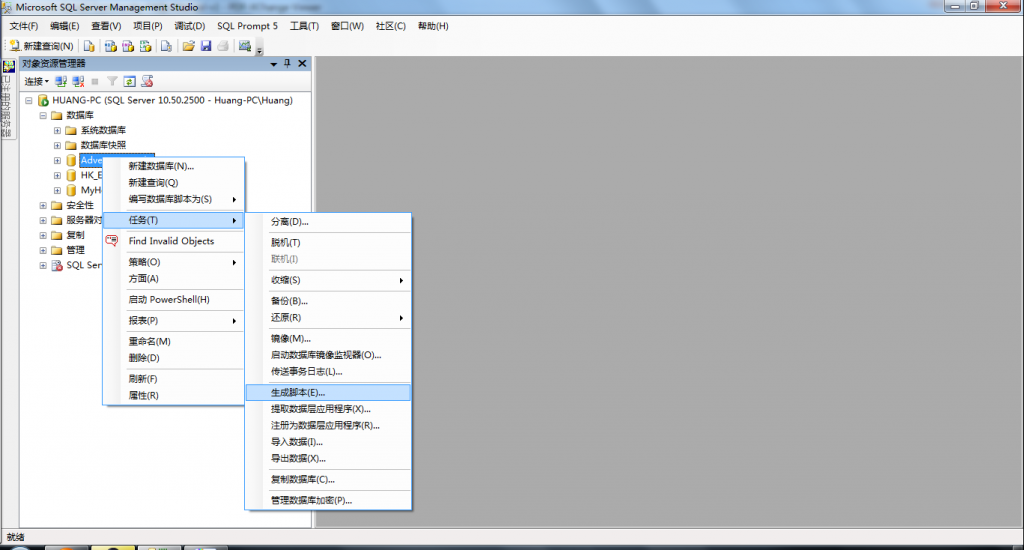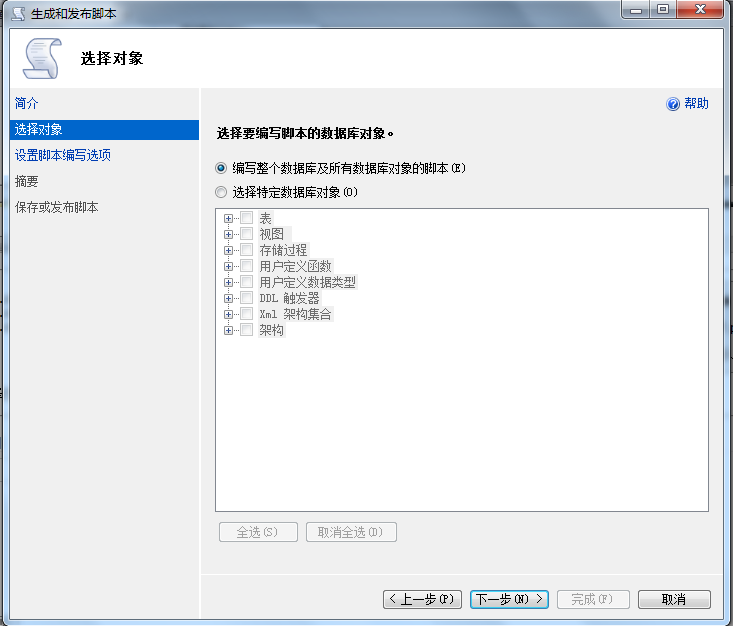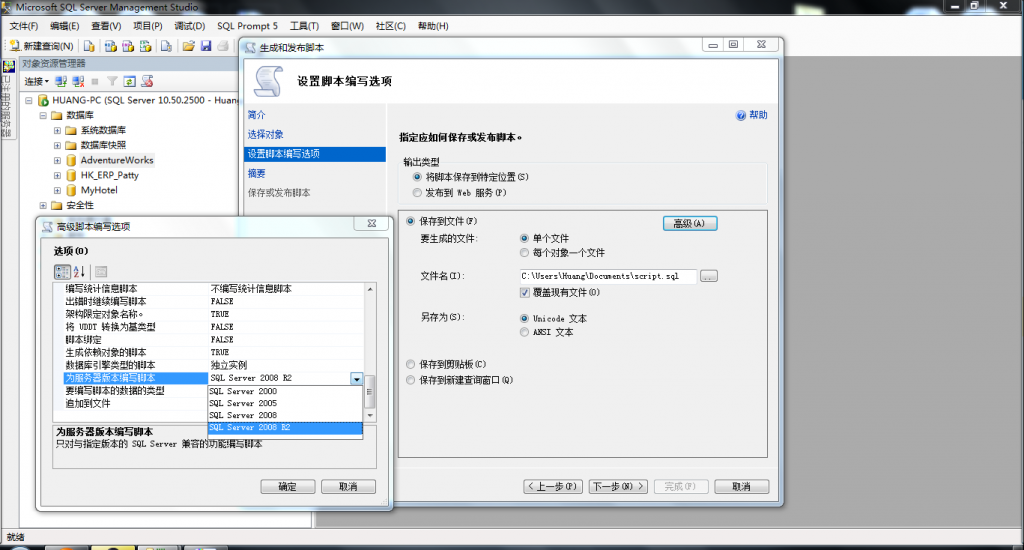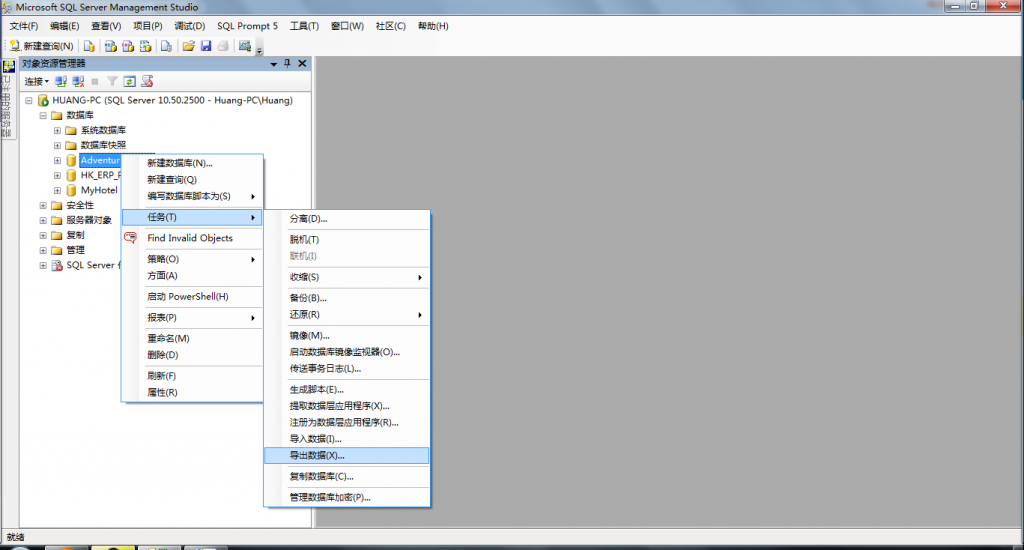- ubuntu12.04环境下使用kvm ioctl接口实现最简单的虚拟机
- Ubuntu 通过无线网络安装Ubuntu Server启动系统后连接无线网络的方法
- 在Ubuntu上搭建网桥的方法
- ubuntu 虚拟机上网方式及相关配置详解
CFSDN坚持开源创造价值,我们致力于搭建一个资源共享平台,让每一个IT人在这里找到属于你的精彩世界.
这篇CFSDN的博客文章SQLServer数据库从高版本降级到低版本实例详解由作者收集整理,如果你对这篇文章有兴趣,记得点赞哟.
SQLServer数据库从高版本降级到低版本实例详解 。
由于目前还广泛使用着SQLServer2000,很多公司又想使用新的SQLServer,从而直接【分离/附加】或者【备份/还原】数据库,在不同版本之间存放。往往就会遇到版本不兼容的问题。前几天遇到了从我本机2008R2上备份的一个数据库还原到2008上面时报错:
从运行版本10.50.2500(2008R2是10.50)和10.00.1600(2008是10.00)中可以看出这个版本不兼容问题,大部分情况下,从低版本升级到高版本,只要不是跨度太大,如2000升级到2012,都不会怎么报错。除非使用了一些新版本不兼容的特性如*=来实现left join的语句。但是就像上图那样,从高版本还原到低版本的时候,问题就出现了,而且几乎一定会报错.
下面给出几个小建议,例子是从2008 降级到2005:
方法一:使用图形化操作(GUI),打开SSMS(SQL Server Management Studio) 。
。
步骤1:右键你要降级的数据库,按下图选择:
。

步骤2:在对话框中选择:

步骤3:在【高级】中选择下图:
。

步骤4:把脚本保存起来,然后在SQLServer2005中运行脚本.
详细步骤可以看:http://bbs.csdn.net/topics/390438560?page=1#post-394316973 中的13楼的回复,有截图 。
步骤5:通过【任务】→【导入数据】,把数据从2008导入到使用脚本创建的库上如下图,就完成了:
。

方法二:使用系统自带的存储过程实现:sp_dbcmptlevel ——将某些数据库行为设置为与指定的 SQL Server 版本兼容 。
下面是其内部实现代码:
|
1
2
3
4
5
6
7
8
9
10
11
12
13
14
15
16
17
18
19
20
21
22
23
24
25
26
27
28
29
30
31
32
33
34
35
36
37
38
39
40
41
42
43
44
45
46
47
48
49
50
51
52
53
54
55
56
57
58
59
60
61
62
63
64
65
66
67
68
69
70
71
72
73
74
75
76
77
78
79
80
81
82
83
84
85
86
87
88
89
90
91
92
93
94
95
96
97
98
99
100
101
|
SET
QUOTED_IDENTIFIER
ON
SET
ANSI_NULLS
ON
GO
create
procedure
sys.sp_dbcmptlevel
-- 1997/04/15
@dbname sysname =
NULL
,
-- database name to change
@new_cmptlevel tinyint =
NULL
OUTPUT
-- the new compatibility level to change to
as
set
nocount
on
declare
@exec_stmt nvarchar(
max
)
declare
@returncode
int
declare
@comptlevel
float
(8)
declare
@dbid
int
-- dbid of the database
declare
@dbsid varbinary(85)
-- id of the owner of the database
declare
@orig_cmptlevel tinyint
-- original compatibility level
declare
@input_cmptlevel tinyint
-- compatibility level passed in by user
,@cmptlvl80 tinyint
-- compatibility to SQL Server Version 8.0
,@cmptlvl90 tinyint
-- compatibility to SQL Server Version 9.0
,@cmptlvl100 tinyint
-- compatibility to SQL Server Version 10.0
select
@cmptlvl80 = 80,
@cmptlvl90 = 90,
@cmptlvl100 = 100
-- SP MUST BE CALLED AT ADHOC LEVEL --
if (@@nestlevel > 1)
begin
raiserror(15432,-1,-1,
'sys.sp_dbcmptlevel'
)
return
(1)
end
-- If no @dbname given, just list the valid compatibility level values.
if @dbname
is
null
begin
raiserror (15048, -1, -1, @cmptlvl80, @cmptlvl90, @cmptlvl100)
return
(0)
end
-- Verify the database name and get info
select
@dbid = dbid, @dbsid = sid ,@orig_cmptlevel = cmptlevel
from
master.dbo.sysdatabases
where
name
= @dbname
-- If @dbname not found, say so and list the databases.
if @dbid
is
null
begin
raiserror(15010,-1,-1,@dbname)
print
' '
select
name
as
'Available databases:'
from
master.dbo.sysdatabases
return
(1)
end
-- Now save the input compatibility level and initialize the return clevel
-- to be the current clevel
select
@input_cmptlevel = @new_cmptlevel
select
@new_cmptlevel = @orig_cmptlevel
-- If no clevel was supplied, display and output current level.
if @input_cmptlevel
is
null
begin
raiserror(15054, -1, -1, @orig_cmptlevel)
return
(0)
end
-- If invalid clevel given, print usage and return error code
-- 'usage: sp_dbcmptlevel [dbname [, compatibilitylevel]]'
if @input_cmptlevel
not
in
(@cmptlvl80, @cmptlvl90, @cmptlvl100)
begin
raiserror(15416, -1, -1)
print
' '
raiserror (15048, -1, -1, @cmptlvl80, @cmptlvl90, @cmptlvl100)
return
(1)
end
-- Only the SA or the dbo of @dbname can execute the update part
-- of this procedure sys.so check.
if (
not
(is_srvrolemember(
'sysadmin'
) = 1))
and
suser_sid() <> @dbsid
-- ALSO ALLOW db_owner ONLY IF DB REQUESTED IS CURRENT DB
and
(@dbid <> db_id()
or
is_member(
'db_owner'
) <> 1)
begin
raiserror(15418,-1,-1)
return
(1)
end
-- If we're in a transaction, disallow this since it might make recovery impossible.
set
implicit_transactions
off
if @@trancount > 0
begin
raiserror(15002,-1,-1,'sys.sp_dbcmptlevel
')
return (1)
end
set @exec_stmt = '
ALTER
DATABASE
' + quotename(@dbname, '
[
') + '
SET
COMPATIBILITY_LEVEL = ' +
cast
(@input_cmptlevel
as
nvarchar(128))
-- Note: database @dbname may not exist anymore
exec
(@exec_stmt)
select
@new_cmptlevel = @input_cmptlevel
return
(0)
-- sp_dbcmptlevel
GO
|
语法 。
|
1
|
sp_dbcmptlevel [ [ @dbname = ]
name
] [ , [ @new_cmptlevel = ] version ]
|
参数 。
|
1
|
[ @dbname = ]
name
|
要为其更改兼容级别的数据库的名称。数据库名称必须符合标识符的规则。name 的数据类型为 sysname,默认值为 NULL.
[ @new_cmptlevel = ] version 。
数据库要与之兼容的 SQL Server 的版本。version 的数据类型为 tinyint,默认值为 NULL。该值必须为下列值之一:
80 = SQL Server 2000 。
90 = SQL Server 2005 。
100 = SQL Server 200 。
返回代码值 。
。
0(成功)或 1(失败) 。
注意事项:
后续版本的 Microsoft SQL Server 将删除该功能。请不要在新的开发工作中使用该功能,并尽快修改当前还在使用该功能的应用程序。 改为使用 ALTER DATABASE 兼容级别.
感谢阅读,希望能帮助到大家,谢谢大家对本站的支持! 。
原文链接:http://blog.csdn.net/dba_huangzj/article/details/7952403 。
最后此篇关于SQLServer数据库从高版本降级到低版本实例详解的文章就讲到这里了,如果你想了解更多关于SQLServer数据库从高版本降级到低版本实例详解的内容请搜索CFSDN的文章或继续浏览相关文章,希望大家以后支持我的博客! 。
是否可以将 Azure 云服务实例从“小型”虚拟机降级为“超小型”虚拟机? 到目前为止我尝试过的:- 将 Visual Studio 中的 VM 更改为“超小”- 构建了一个新包- 上传到门户网站-
几天前我更新了 Jenkins 。但是在当前的 Jenkins 版本中,存在一些烦人的 bug。是否可以降级 Jenkins 的版本,如果可以,怎么可能? 最佳答案 最近我也一直在努力降级 Jenki
我已经安装了 Android SDK 4.0.3,我想安装一个先行版本(例如 2.2),所以我应该卸载 4.0.3 版本吗? 怎么做? 最佳答案 只需在 Android SDK 管理器中安装所需的 S
最近我更新了我的 android 游戏,编辑 sqlite 数据库在我的表中添加新字段,更新后,我收到 4 个崩溃报告(其中 3 个来自同一设备,Samsung Galaxy S4) android.
思考:当活动服务出现性能问题以后,我们只能眼睁睁看着活动服务被压垮吗? 1、添加@HystrixCommand后,Hystrix是如何实现超时和降级功能? 1、 在某个方法上添加了@Hystrix
将 Magento 商店从企业版 1.10.1.1 降级到社区版 1.7.0.0 应遵循什么程序? 我做的步骤是: 备份 Magento EE 1.10.1.1 数据库 :) 将此数据库导入到一个名为
一个问题,因为我可以卸载并安装旧版本的 map 服务器,因为我导致大致以下错误,我认为是相同的版本 警告:[MapServer 错误]:msLoadSymbolSet():第一个标记必须是 SYMBO
如何降级我的 flutter 版本以避免空安全?我更新了,这个功能出现了,但我使用了一些包,比如徽章和 https,这些包没有更新为空安全,我得到了几个错误来运行我的代码。 我的pubspec: 环境
我已经为 Mysql 和 DBI 安装了 Perl 模块,但是由于我在当前版本中遇到的错误,我想将它们降级到旧版本。是否可以使用 cpan 将它们降级为旧版本?我该怎么做? 最佳答案 要强制安装特定版
我有一些关于 azure sql 升级/降级的问题。我发现的唯一信息是,要升级/降级,您必须导出 .bacpac 并将其导入到新的升级/降级服务器上。 当更新版本的 azure sql 可用时,Mic
关闭。此题需要details or clarity 。目前不接受答案。 想要改进这个问题吗?通过 editing this post 添加详细信息并澄清问题. 已关闭 5 年前。 Improve th
我是 Android 开发的新手,我想我可能犯了一个错误。我一直在我的 build.gradle 文件中使用 compileSdkVersion 25。但我希望我的应用程序支持 Android 4.1
我使用它,它在 webkit 浏览器上运行良好,在 firefox 上运行简单。但是 Opera 给出了奇怪的结果。 我正在使用的 CSS: color:@coreDarkBlue; backgrou
我需要打开一个文件,对其进行读取锁定,然后尝试获取写入锁定,但如果失败则保留读取锁定。 这在使用 fcntl 锁定的 POSIX 中效果很好。 在 Windows 中,我可以使用 LockFileEx
我已经安装了 Xamarin(Xamarin studio、Xamarin.Android)但是即使是最简单的项目构建也存在一些问题(只需创建新项目->构建->出现错误)。 经过一些谷歌搜索后,我发现
关闭。这个问题是off-topic .它目前不接受答案。 想改善这个问题吗? Update the question所以它是 on-topic对于堆栈溢出。 8年前关闭。 Improve this q
我在尝试使用 Pyinstaller 时遇到错误。在做了一些研究之后,我认为该错误是由最新版本的 setuptools (19.3) 中的错误引起的。该修复程序似乎正在降级到 setuptools 版
我正在尝试使用 Angular 升级机制将我们的 ng1 项目升级到 ng2。实际上,我重写了一个组件,它提供了多个内容( Angular 为 1.5 的多重包含/插槽)。 我的问题是,它可以在一个组
我在 Ubuntu 服务器上本地托管 Gitlab。 在没有检查 Ubuntu 18.04 版本是否支持 Gitlab 的情况下,我刚刚安装了它。 现在我注意到我无法将我的 Gitlab 安装更新到最
假设 iOS 自动续订订阅提供对包含存储分配的服务的访问。有多个订阅级别,其允许的存储量各不相同。订阅者可能希望随着存储需求的变化而升级或降级其订阅。 StoreKit 文档向我展示了如何开始订阅,但

我是一名优秀的程序员,十分优秀!